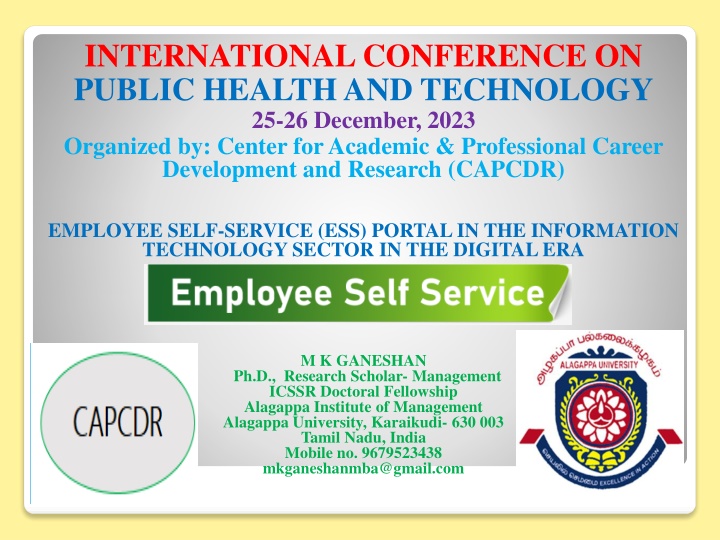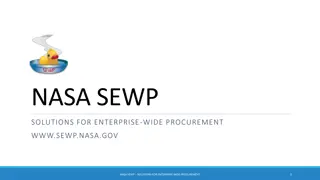
Exploring the Impact of Employee Self-Service (ESS) Portals in the IT Sector
Discover the significance of Employee Self-Service (ESS) portals in the digital era, focusing on how they enhance operational efficiency, empower employees, ensure data security, and streamline HR processes in the Information Technology sector.
Download Presentation

Please find below an Image/Link to download the presentation.
The content on the website is provided AS IS for your information and personal use only. It may not be sold, licensed, or shared on other websites without obtaining consent from the author. If you encounter any issues during the download, it is possible that the publisher has removed the file from their server.
You are allowed to download the files provided on this website for personal or commercial use, subject to the condition that they are used lawfully. All files are the property of their respective owners.
The content on the website is provided AS IS for your information and personal use only. It may not be sold, licensed, or shared on other websites without obtaining consent from the author.
E N D
Presentation Transcript
INTERNATIONAL CONFERENCE ON PUBLIC HEALTH AND TECHNOLOGY 25-26 December, 2023 Organized by: Center for Academic & Professional Career Development and Research (CAPCDR) EMPLOYEE SELF-SERVICE (ESS) PORTAL IN THE INFORMATION TECHNOLOGY SECTOR IN THE DIGITAL ERA M K GANESHAN Ph.D., Research Scholar- Management ICSSR Doctoral Fellowship Alagappa Institute of Management Alagappa University, Karaikudi- 630 003 Tamil Nadu, India Mobile no. 9679523438 mkganeshanmba@gmail.com
The contemporary era is referred to as the "digital age," and digital transformation has become a worldwide corporate consensus. 5G, cloud computing, big data, artificial intelligence, IoT, blockchain, and other technologies have transformed the workplace. Yu & JInajun (2020). In the fast-paced landscape of the digital era, the Information Technology (IT) sector is continually evolving, necessitating innovative solutions to adapt to changing workplace dynamics. One such transformative tool is the Employee Self-Service (ESS) portal, a digital gateway that empowers employees to autonomously manage various Human Resources (HR) functions. This introduction explores the profound impact of ESS portals in the IT sector, where technological advancements intersect with the demands of a dynamic workforce. As organizations embrace digital transformation, ESS portals play a crucial role in reshaping traditional HR processes. These portals serve as a centralized hub, enabling employees to seamlessly navigate through tasks like leave management, time tracking, and benefits administration.. User experience (UX) takes center stage in this digital narrative, with ESS portals designed to provide intuitive interfaces and mobile accessibility. ESS portals become integral to daily operations, their ability to ensure data privacy and protection is a critical aspect of their functionality. The security requirements for an ESS portal are substantially greater and should include multi- factor authentication. Another difficulty is keeping the knowledge database up-to-date.
OBJECTIVES OF THE STUDY The present study tries to explore the Employee Self-Service (ESS) Portal in the information technology sector in the digital world. The objectives of this study are The purpose of implementing an Employee Self-Service (ESS) portal in the information technology sector is to enhance operational efficiency and employee satisfaction by providing a centralized platform. To empower employees to independently manage HR-related tasks, such as leave requests, time tracking, and benefits management. The overarching goal is to streamline administrative processes, improve communication, and create a more agile and responsive work environment in alignment with the dynamic nature of the IT sector. The ESS portal seeks to ensure data security and compliance with regulations, safeguarding sensitive employee information.
REVIEW OF LITERATURE Jie Zhang & Zhisheng Chen (2023), Exploring Human Resource Management Digital Transformation in the Digital Age , analyze the essence of human resource management digital transformation, such as the digital workplace, digital human resource management procedures, and digital employee services. According to the report, digital human resource management procedures refer to the execution of selection, training and development, and evaluation functions using cutting-edge digital technology. It is emphasized that, while digital transformation improves company development, its possible consequences, such as how old and new human resource management systems are converted and the negative repercussions of the new system, cannot be overlooked. Lestari Margatama (2017), Employee Self-Service-Based Development and Implementation, Case Study: BCP Indonesia A Human Resources Information System is a Decision Support System that offers vital information on an organization human resources. Web-based e-HR is one of the most practical human resource management systems, allowing employees to focus on their jobs rather than HR administration processes. Employee happiness is projected to improve as a result of introducing Employee Self-Service (ESS), as is employee performance. The web-based ESS is distinguished by a personalized information strategy that provides personalized and managed services on information access as well as a structured workflow procedure. The subject of this study is the HR administration of PT.BCP to construct and deploy ESS using system prototype development and a UML modeling tool. The resultant system is intended to provide rapid access to information and corporate procedures to save the time required for BCP's staff administration and paperwork. Janet H. Marler and James Dulebohn (2005), A Model of Employee Self-Service Technology Acceptance , examine the literature on individual technology adoption to demonstrate how organizations may increase the successful use of human resource web-based technologies. Develop a perceptual model of employee self-service (ESS) acceptability and utilization by integrating and expanding multiple theoretical theories of technology acceptance. Suggest numerous crucial human, technical, and organizational aspects relevant to individual intents to utilize ESS technology based on this model. Summarise them into a few testable hypotheses and examine the consequences for organizational researchers and practitioners. Human Resources Information System
The following research methodology has been adopted for the current research work based on the secondary data. Secondary Data This study is conceptual framework and descriptive nature in research. The study primarily relied on secondary data as there was no primary research conducted. The research study is using a descriptive research design. The secondary data has been collected from research papers, publications, websites, HR blogs, and survey reports published by various research organizations. Source of Data: Secondary data- collected from research gate, Google scholar, mendeley software and search engine websites.
EMPLOYEE SELF-SERVICE Employee Self-Service, or ESS, is a web-based portal that allows workers to view and manage personal information such as contact information, job descriptions, pay stubs, tax forms, time off balances, and other work-related information. Employees may also use this system to update their personal information and submit requests, such as for leave, training, or assets. ESS can be accessed via a desktop or mobile application, allowing employees to view their information from any location at any time. This solution removes the need for workers to contact HR or their line managers for simple information or requests, freeing up their time and decreasing HR and management's effort. Employee Self-Service (ESS) is becoming an increasingly popular approach for businesses of all sizes. Employees may access their personal information and manage work-related duties via an online portal, eliminating the need for physical documentation and decreasing the administrative burden on HR and management. Employee Self-Service (ESS) has grown in popularity in recent years as a result of the rising reliance on technology and the growing demand for organizations to simplify their processes.
MODERN HR TECHNOLOGY SOLUTIONS Organizations may empower their workers by providing them with more authority over HR-related duties and information using modern HR technology solutions. Streamlined Onboarding: Self-service HR technology streamlines the on boarding process by allowing new recruits to submit paperwork, access training materials, and set up direct deposits when and where they choose. This promotes a more seamless transition within the organisation. Effortless Benefits Management: Employees may register for benefits, update personal information, and even access tools to better understand their options with the press of a button. It gives them back the ability to choose. Access to Payroll Information: Employees no longer have to wait for paper pay stubs or call HR to find out how much they are paid. Self-service HR technology allows users to access their payroll information, including tax papers, at any time and from any location. Personalized Career Development: Many platforms provide learning and development materials that are suited to the interests and aspirations of employees. Enhanced Communication: For rapid HR questions, self-service websites frequently contain chatbots or messaging options. This increases communication by eliminating the need for long email threads or phone calls. Data-Driven Decision-Making: HR technology delivers useful information on employee engagement, turnover, and other measures. This data may be used by HR experts to make educated decisions that benefit both people and the organization.
Benefits for employees Increased Control: Allows employees to take control of their personal information and work-related tasks, reducing their reliance on HR and management. Improved Work-Life Balance: Make it easier for employees to manage their work- related tasks, such as applying for leave or submitting expenses, allowing them to have a better work-life balance. Faster Access to Information: Employees can access their information quickly and easily, reducing the need for them to contact HR or their line managers. Enhanced Career Development: Provides employees with access to training and development opportunities, allowing them to enhance their skills and progress in their careers. Benefits for Organizations Reduced Costs: Reduces the costs that are associated with administrative tasks, such as printing, filing, and manual data entry. Overall, reducing time and money spent. Increased Productivity: Increases productivity by streamlining processes and reducing the administrative burden on HR and management. Improved Data Accuracy: It can improve data accuracy by reducing the risk of errors associated with manual data entry and paperwork. Enhanced Compliance: This helps organization comply with legal and regulatory requirements, reducing the risk of non-compliance and associated penalties.
ESS: APPLICATIONS HR self-service increases employees' authority and access to information in a self-help environment, freeing up managers' time and elevating their profile. Log in or out and see the information instantly. Request PTO Examine the attendance information used for payroll. Request a correction to the attendance data. Check the work schedule or shift plans. Share documents with HR. Examine corporate guidelines and additional common materials. Access training materials. Submit income tax declarations and verify income tax calculation. Participate in performance appraisals.
BASED ON TRENDS AND DATA Adoption Rates: Adoption of ESS portals has been consistently high, with a significant percentage of IT companies implementing such systems to streamline HR processes. Mobile Usage: The use of mobile devices to access ESS portals has seen a notable increase, reflecting the need for remote access and on-the-go functionality in the digital era. Remote Work Impact: The COVID-19 pandemic accelerated the trend of remote work, influencing the design and functionality of ESS portals to better support virtual collaboration and communication. Security Concerns: Given the sensitivity of HR data, there has been a heightened focus on cybersecurity within ESS portals. Data encryption, multi-factor authentication, and secure transmission protocols are increasingly emphasized. User Experience (UX): The digital era has brought about a shift towards more user-friendly and intuitive interfaces for ESS portals, enhancing the overall user experience and increasing employee engagement. Integration with Cloud Services: Cloud-based ESS solutions have gained popularity, allowing for greater flexibility, scalability, and accessibility from various locations and devices. Data Analytics and Insights: Organizations are increasingly leveraging data analytics within ESS portals to gain insights into employee behavior, preferences, and trends, facilitating data-driven decision-making. Training and Support: Companies are investing in training programs to ensure employees are proficient in using ESS portals. Additionally, support mechanisms such as chatbots or dedicated help desks contribute to a smoother user experience. Compliance and Data Privacy: Compliance with data privacy regulations and standards (such as GDPR) remains a top priority, with organizations implementing measures to safeguard employee data and ensure legal compliance. Cost Savings and Efficiency: Organizations are witnessing cost savings through reduced administrative overhead, paperless processes, and increased efficiency in HR operations after implementing ESS portals.
FUTURE STUDY Investigate the potential of incorporating advanced artificial intelligence (AI) features in ESS portals to automate more complex HR processes and provide personalized employee interactions. Explore the use of predictive analytics within ESS portals to anticipate HR trends and employee needs and optimize workforce management strategies in the rapidly changing IT environment. Assess the feasibility and benefits of integrating blockchain technology into ESS portals to enhance data security, transparency, and trust in HR transactions. Examine the integration of Internet of Things (IoT) devices within ESS portals to monitor employee well-being, provide insights for wellness programmes, and foster a healthier work environment. Research innovative ways to enhance the user experience in ESS portals, considering immersive technologies like augmented reality (AR) or virtual reality (VR) for more engaging and interactive HR interactions. Investigate strategies for ESS portals to efficiently manage global HR compliance requirements and localization features to cater to diverse cultural and regulatory contexts. Explore features within ESS portals that facilitate employee skill development, training, and career advancement, aligning HR practices with the ongoing learning needs in the IT sector. Conduct a comprehensive study on emerging cybersecurity threats and advancements, proposing strategies to enhance the resilience of ESS portals against evolving cyber risks in the digital era. Investigate tools and functionalities within ESS portals to optimize remote work experiences, including collaboration features, virtual team-building activities, and strategies for maintaining a connected virtual workforce. Examine how ESS portals can contribute to sustainability initiatives within the IT sector, such as reducing paper usage, promoting eco-friendly HR practices, and aligning with corporate social responsibility goals.
CONCLUSION In the digital era, the implementation of Employee Self-Service (ESS) portals within the Information Technology (IT) sector marks a transformative shift in the management of Human Resources (HR) processes. This study has delved into the multifaceted impact of ESS portals, showcasing their pivotal role in aligning HR practices with the dynamic demands of the IT landscape. The digital transformation of HR processes has not only streamlined administrative tasks but has also redefined the employee experience. The intuitive design and mobile accessibility of ESS portals contribute significantly to user satisfaction, reflecting the sector's commitment to embracing technological innovation for efficient workflow management. Security considerations, paramount in the digital era, underscore the need for robust cybersecurity measures within ESS portals. The Employee Self-Service Portal stands as a cornerstone in the digital evolution of HR practices within the IT sector. Its impact on organizational efficiency, user experience, and adaptability positions it as an indispensable tool for navigating the complexities of the digital era. As the IT sector continues to evolve, embracing and optimizing ESS portals will be key to fostering a resilient, responsive, and digitally empowered workforce.
REFERENCES Benson, A. D., Johnson, S. D., & Kuchinke, K. P. (2002). The use of technology in the digital workplace: A framework for human resource development . Advances in Developing Human Resources, 4(4), 392 404. Bobbitt, M., & Dabholkar, P. (2001). Integrating Attitudinal Theories to Understand and Predict Use of Technology-Based Self-Service," International Journal of Service Industry Management, 12, 423 450. Bondarouk, T. V., & Ru l, H. J. M. (2009). Electronic Human Resource Management: Challenges in the Digital Era . The International Journal of Human Resource Management, 20(3), 505 514. Janet H. Marler and James Dulebohn (2005), A Model of Employee Self-Service Technology Acceptance," Research in Personnel and Human Resources Management, 24:137 180. DOI:10.1016/S0742-7301(05)24004-5 Jie Zhang & Zhisheng Chen (2023), Exploring Human Resource Management Digital Transformation in the Digital Age," Journal of the Knowledge Economy, 1 17. https://doi.org/10.1007/s13132-023-01214-y Lestari Margatama (2017), Employee Self-Service-Based Human Resources Information System Development and Implementation, Case Study: BCP Indonesia, Jurnal Informatika, 11(1), 52 60. o Schneider, B. (1994). "HRM: A service perspective . International Journal of Service Industry Management, 5(1), 64 76. Yu, Z., & Inajun, N. (2020). How to achieve HRM digital transformation . available at: https://www.sohu.com/a/400600846_343325. https://spinetechnologies.com/blogs/what-is-employee-self-service-and-how-is-it-beneficial-for-your- organization/
















